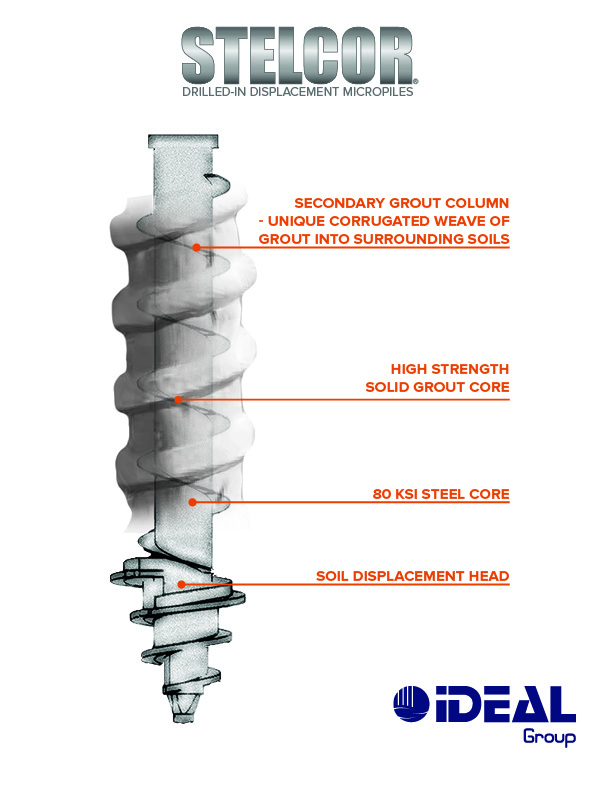STELCOR uses the elements of a traditional micropile and gets them in the ground cleaner and faster. The STELCOR pile takes advantage of the strengths of steel and grout, uses relatively small installation equipment, produces no spoils, and consistently produces better results than were projected in design.
With STELCOR, the soil is displaced and not removed. The result is greater loads at lesser depths. The STELCOR pile is embedded into the improved soil with a unique corrugated weave of grout which greatly enhances the soil bond and load transfer capacity. From structural, geotechnical, mechanical, and installation standpoints, STELCOR just makes sense, and the load test results prove it.
One of the many benefits of STELCOR DDM is that it can be used in situations where similar deep foundations would not have been feasible due to costly spoils removal, time constraints, limited access, and other factors. STELCOR DDMs are installed using minimal installation equipment – this can result in significant savings on mob/demob costs compared to similar pile types. STELCOR really excels in challenging environments where tight access and high-water tables are present. Another benefit of STELCOR DDM is that no spoils are created during installation. This is especially beneficial on sites where contamination is present and/or where spoils removal is costly.
For quality assurance purposes, STELCOR DDMs are only installed by IDEAL Certified Installers. For more information Contact Us and we will be happy to answer any questions you may have.

DOWNLOAD/VIEW DESIGN AND INSTALL INFO:
TECHNICAL EXPLANATION
STELCOR Drilled-In Displacement Micropiles are installed using hydraulic powered rotary equipment and are turned into the ground while crowd or downward pressure is exerted on the steel core and a continuous flow of grout is provided to the top of the pile. Reverse grout flow flighting welded to the steel core draws the grout into the annulus created by a displacement head located near the tip of the steel core.
The welded reverse flighting ensures a continuous grout column and structural load transfer from the grout column into the 55 to 80 ksi steel core.
Grout ports in the steel core also provide consistent grout placement along the length of the pile.
No soil is removed during installation of STELCOR Drilled-In Displacement Micropiles and a new steel core is installed and left in the ground for every pile.
The STELCOR displacement lead section includes a helicoidal driving plate, a lateral displacement plate, and a secondary deformation structure.
The driving plate helps advance the pile downward and provides end bearing support.
The lateral displacement plate creates a positive annulus around the steel core by displacing the soil outward, enhancing the density surrounding the pile element.
The secondary deformation structure produces a ribbed or corrugation effect along the grouted pile shaft, greatly enhancing soil bond and load transfer.
A continuous grout column is there by created by means of the STELCOR displacement lead section and reverse grout flow flighting. The steel structural core extends the entire length of the pile ensuring unbroken structural integrity.
ONE OR MORE OF THE FOLLOWING PATENTS MAY APPLY:
US 8,926,228 B2 & US 10,480,144 B2; OTHER PATENTS PENDING.
ADVANTAGES

Vibrationless Installation
STELCOR DDMs are installed with almost zero vibration. This is why they’re a preferred deep foundation when deep foundations are required near schools, hospitals, historical buildings, or any structure with an already compromised foundation.

High Water Table Installation
Grout is heavier than water, so even if there is groundwater present, the grout flows continuously and fills the voids created by the pile installation.

Minimal Mobilization and Demobilization Costs
Hauling equipment to and from a site is costly and time-consuming, especially in metropolitan areas. Depending on the project, this may have to be done several times over the course of the pile installation. The only equipment needed for installing STELCOR DDMs is an excavator or skid-steer, a hydraulic-powered rotary drive head, and a high sheer colloidal grout mixer. With no specialty cumbersome installation equipment setup, on-site mobilization and demobilization is a cakewalk.

No Soil Removal
As the pile is installed, the lateral displacement plate on the tip of the STELCOR DDM pile displaces the soil. Not only does this eliminate the cost of removing spoils (even more costly when contaminated), it also enhances the density of the soils surrounding the pile.
Additional Benefits:
- Exceptional lateral capacity
- No reduction in bending capacity at the bolted connection
(unlike threaded connections) - Predictable grout volumes and placement
- Positive grout displacement
- Lower cost per kip of support compared to most other pile types
- Can be installed in tight access and low overhead environments
What is the Cost of Pile Per Foot?
When considering material cost with STELCOR DDMs, it’s important to consider all the factors in order to know your true cost per foot of piling. As one developer so perfectly put it, “I want to know my cost-per-kip of support with each piling option, not my cost per foot of material.” Below are a few points to help you drill down and understand the true cost per foot of STELCOR DDM’s vs other piling options.
Materials
Depending on the soil type, a STELCOR DDM pile will often achieve the same or higher capacity as other pile types while being installed to lesser depths.
Equipment
To install STELCOR DDMs, you need a high shear colloidal grout mixer, a hydraulic rotary drive head, and an excavator or mini-skid (one or both of which are often already on site). What installation equipment is needed to install other pile types and what is the cost of getting that equipment on site?
Time
If a pile can be installed to a lesser depth while achieving the same capacity, this will save even more time and money. How quickly can a STELCOR DDM pile be installed vs. other piling options? A 60′ STELCOR DDM pile can easily be installed in 30 minutes. That included placing the initial 20′ lead section, installing it, adding two more 20′ extensions and installing them, and then moving to the next pile location.
Our design team provides preliminary design options to give our clients the lowest cost per kip of support, and it costs the client nothing. Click here to send your project info to the IDEAL Design Team.
INSTALLATION SEQUENCE AND GROUT TAKE ESTIMATION FOR STELCOR
PART 1. GENERAL DESCRIPTION
DDM’s are installed using hydraulic powered rotary equipment and are turned into the ground while crowd or downward pressure is exerted on the steel core and a continuous flow of grout is provided to the top of the pile. A reverse flighting welded to the steel shaft draws the grout into the annulus created by a displacement head located near the tip of the steel core.
PART 2. INSTALLATION SEQUENCE
1. Attach the hydraulic drive head to the DDM lead section and align pile tip at specified pile location.
2. Advance the lead section 12 inches below ground and lift up, removing soil, to create a grout reservoir. Remove soil from extracted pile tip, fill the reservoir with grout, and re-insert lead section.
3. As the lead section advances beyond the grout reservoir, commence grout flow. Monitor and record grout take during entire installation of each pile using the STELCOR pile installation record provided. A grout flow meter can be utilized to increase grout volume measurement accuracy.
4. Grout shall flow continuously to fill the annulus created by the DDM displacement head. Maintain grout level within 24 inches of installation grade.
5. Sufficient crowd shall be applied to the pile throughout the entire installation process to ensure 6 inches of advancement per revolution.
6. Where extensions are required, stop the drive head and remove from lead section.
7. Attach the hydraulic drive head to a DDM extension section.
8. Attach the extension section to the lead section with specified hardware and continue installation. Add extensions as required to reach design depth.
9. If dense soils or obstructions are encountered and the pile will not advance, reverse the pile 24 inches and re-advance. Repeat 3 to 5 times while measuring how much the pile advances each time. Do not exceed maximum specified torque of the shaft. If the pile will not advance, then pre-auguring may be required to reach design depth. Consult with Ideal to determine if the pile can be terminated in dense/stiff layers above design depth.
10. If the pile top is terminated above the pile cut-off elevation, cut the steel core using an appropriate method such as a band saw or torch.
11. Upon completion of pile installation, ensure that the grout level is brought to the top of pile (inside and outside of the steel core).
12. Install steel pile cap if applicable.
13. Document installation torque every 5 feet during installation and at pile termination using the STELCOR pile installation record provided. Pile capacity is not determined by installation torque and data is used as reference only.
PART 3. GROUT TAKE APPROXIMATIONS
Recommended grout mix of 0.44 water to cement (W/C) or 94 lb. bag to 5 gallons of water using Type I/II Portland cement. A colloidal mixer must be used.
• STELCOR 1200 – 0.38 Cubic ft. per lineal foot (0.33 bags per lineal foot)
• STELCOR 1400 – 0.44 Cubic ft. per lineal foot (0.38 bags per lineal foot)
• STELCOR 1600 – 0.67 Cubic ft. per lineal foot (0.59 bags per lineal foot)
• STELCOR 1800 – 0.88 Cubic ft. per lineal foot (0.77 bags per lineal foot)
• STELCOR 2000 – 1.15 Cubic ft. per lineal foot (1.00 bags per lineal foot)
Note: Published grout take approximations are for bidding purposes only. Actual grout take will vary depending on soil type. The test pile(s) establishes the installation parameters including depth, grout take, and capacity for production piles in the site-specific soil.
View our completed STELCOR PROJECTS nationwide below:

